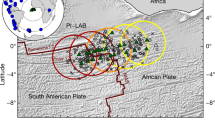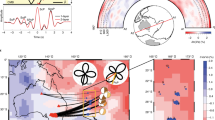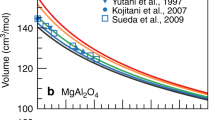Abstract
The dynamics of Earth’s mantle are not well known1. Deciphering mantle flow patterns requires an understanding of the global distribution of mantle density2,3. Seismic tomography has been used to derive mantle density distributions, but converting seismic velocities into densities is not straightforward4,5. Here we show that data from the GOCE (Gravity field and steady-state Ocean Circulation Explorer) mission6 can be used to probe our planet’s deep mass structure. We construct global anomaly maps of the Earth’s gravitational gradients at satellite altitude and use a sensitivity analysis to show that these gravitational gradients image the geometry of mantle mass down to mid-mantle depths. Our maps highlight north–south-elongated gravity gradient anomalies over Asia and America that follow a belt of ancient subduction boundaries, as well as gravity gradient anomalies over the central Pacific Ocean and south of Africa that coincide with the locations of deep mantle plumes. We interpret these anomalies as sinking tectonic plates and convective instabilities between 1,000 and 2,500 km depth, consistent with seismic tomography results. Along the former Tethyan Margin, our data also identify an east–west-oriented mass anomaly likely in the upper mantle. We suggest that by combining gravity gradients with seismic and geodynamic data, an integrated dynamic model for Earth can be achieved.
This is a preview of subscription content, access via your institution
Access options
Subscribe to this journal
Receive 12 print issues and online access
$259.00 per year
only $21.58 per issue
Buy this article
- Purchase on Springer Link
- Instant access to full article PDF
Prices may be subject to local taxes which are calculated during checkout




Similar content being viewed by others
References
Anderson, D. Top-down tectonics? Science 293, 2016–2018 (2001).
Forte, A. & Mitrovica, J. X. Deep-mantle high-viscosity flow and thermochemical structure inferred from seismic and geodynamic data. Nature 410, 1049–1053 (2001).
Deschamps, F., Trampert, J. & Tackley, P. J. in Superplumes: Beyond Plate Tectonics (eds Yuen, D. A. et al.) 293–320 (Springer, 2007).
Karato, S. & Karki, B. Origin of lateral variation of seismic wave velocities and density in the deep mantle. J. Geophys. Res. 106, 21771–21783 (2001).
Maupin, V. & Park, J. in Treatise on Geophysics Vol. 1 (eds Romanowicz, B. & Dziewonski, A. M.) 289–321 (Elsevier, 2007).
Johannessen, J. et al. The European Gravity Field and Steady-State Ocean Circulation Explorer Satellite Mission: Its impact on geophysics. Surv. Geophys. 24, 339–386 (2003).
Dziewonski, A. M. & Romanowicz, B. in Treatise on Geophysics Vol. 1 (eds Romanowicz, B. & Dziewonski, A. M.) 1–29 (Elsevier, 2007).
Van der Hilst, R. D., Widiyantoro, S. & Engdahl, E. R. Evidence for deep mantle circulation from global tomography. Nature 386, 578–584 (1997).
Trampert, J., Deschamps, F., Resovsky, J. & Yuen, D. Probabilistic tomography maps chemical heterogeneities throughout the lower mantle. Science 306, 853–856 (2004).
Cadio, C. et al. Pacific geoid anomalies revisited in light of thermochemical oscillating domes in the lower mantle. Earth Planet. Sci. Lett. 306, 123–135 (2011).
Mikhailov, V., Pajot, G., Diament, M. & Price, A. Tensor deconvolution: A method to locate equivalent sources from full tensor gravity data. Geophysics 72, 161–169 (2007).
Tapley, B. D., Bettadpur, S., Ries, J. C., Thompson, P. F. & Watkins, M. M. GRACE measurements of mass variability in the Earth system. Science 305, 503–505 (2004).
Rummel, R., Yi, W. & Stummer, C. GOCE gravitational gradiometry. J. Geod. 85, 777–790 (2011).
Fuchs, M. & Bouman, J. Rotation of GOCE gravity gradients to local frames. Geophys. J. Int. 187, 743–753 (2011).
Dziewonski, A. M. & Anderson, D. L. Preliminary reference Earth model PREM. Phys. Earth Planet. Int. 25, 297–356 (1981).
Lithgow-Bertelloni, C., Richards, M. A., Ricard, Y., O’Connell, R. J. & Engebretson, D. C. Toroidal-poloidal partitioning of plate motions since 120 My. Geophys. Res. Lett. 20, 375–378 (1993).
Richards, M. A. & Engebretson, D. C. Large scale mantle convection and the history of subduction. Nature 355, 437–440 (1992).
Van der Voo, R., Spakman, W. & Bijwaard, H. Tethyan subducted slabs under India. Earth Planet. Sci. Lett. 171, 7–20 (1999).
Davaille, A. Simultaneous generation of hotspots and superswells by convection in a heterogeneous planetary mantle. Nature 402, 756–760 (1999).
Rouby, H., Greff-Lefftz, M. & Besse, J. Mantle dynamics, geoid, inertia and TPW since 120 My. Earth Planet. Sci. Lett. 292, 301–311 (2010).
Ricard, Y., Richards, M. A., Lithgow-Bertelloni, C. & Le Stunff, Y. A geodynamic model of mantle density heterogeneity. J. Geophys. Res. 98, 21895–21909 (1993).
Ritsema, J., Deuss, A., van Heijst, H. J. & Woodhouse, J. H. S40RTS: A degree-40 shear-velocity model for the mantle from new Rayleigh wave dispersion, teleseismic traveltime and normal-mode splitting function measurements. Geophys. J. Int. 184, 1223–1236 (2011).
Ren, Y., Stutzmann, E., van der Hilst, R. D. & Besse, J. Understanding seismic heterogeneities in the lower mantle beneath the Americas from seismic tomography and plate tectonic history. J. Geophys. Res. 112, B01302 (2007).
Van der Voo, R., Spakman, W. & Bijwaard, H. Mesozoic subducted slabs under Siberia. Nature 397, 246–249 (1999).
Collins, W. J. Slab pull, mantle convection, and Pangaean assembly and dispersal. Earth Planet. Sci. Lett. 205, 225–237 (2003).
Fukao, Y. et al. Stagnant slabs: A review. Annu. Rev. Earth Planet. Sci. 37, 19–46 (2009).
Replumaz, A., Karason, H., van der Hilst, R. D., Besse, J. & Tapponnier, P. 4-D evolution of SE Asia’s mantle from geological reconstructions and seismic tomography. Earth Planet. Sci. Lett. 221, 103–115 (2004).
Debayle, E. & Ricard, Y. A global shear velocity model of the upper mantle from fundamental and higher Rayleigh mode measurements. J. Geophys. Res. 117, B10308 (2012).
Bijwaard, H., Spakman, W. & Engdahl, E. R. Closing the gap between regional and global travel time tomography. J. Geophys. Res. 103, 30055–30078 (1998).
Simmons, N. A., Forte, A. M., Boschi, L. & Grand, S. P. GyPSuM: A joint tomographic model of mantle density and seismic wave speeds. J. Geophys. Res. 115, B12310 (2010).
Acknowledgements
We thank CNES for financial support through the TOSCA committee, and ESA for access to the GOCE data. We thank J. Besse, O. de Viron and B. Romanowicz for important comments on our manuscript, and G. Hetenyi for discussions on the mantle structure below Tibet. We thank G. Métris for providing us with software for the differentiation of the spherical harmonics, and J. Penguen for assistance in the numerical computations. This is IPGP contribution 3470.
Author information
Authors and Affiliations
Contributions
I.P. and G.P-M. designed the study. I.P., G.P-M., M.G-L. and L.M. analysed the data and performed the geophysical modelling. M.D. and M.M. discussed and commented on the results and implications at all stages. I.P. wrote the manuscript with inputs from all co-authors. L.M. wrote Supplementary Section 2.
Corresponding author
Ethics declarations
Competing interests
The authors declare no competing financial interests.
Supplementary information
Supplementary Information
Supplementary Information (PDF 780 kb)
Rights and permissions
About this article
Cite this article
Panet, I., Pajot-Métivier, G., Greff-Lefftz, M. et al. Mapping the mass distribution of Earth’s mantle using satellite-derived gravity gradients. Nature Geosci 7, 131–135 (2014). https://doi.org/10.1038/ngeo2063
Received:
Accepted:
Published:
Issue Date:
DOI: https://doi.org/10.1038/ngeo2063
This article is cited by
-
The Global Crust and Mantle Gravity Disturbances and Their Implications on Mantle Structure and Dynamics
Surveys in Geophysics (2024)
-
Satellite Gravimetry: A Review of Its Realization
Surveys in Geophysics (2021)
-
Earth’s gravity from space
Rendiconti Lincei. Scienze Fisiche e Naturali (2020)
-
New analytical solution and associated software for computing full-tensor gravitational field due to irregularly shaped bodies
Journal of Geodesy (2019)
-
Earth tectonics as seen by GOCE - Enhanced satellite gravity gradient imaging
Scientific Reports (2018)



